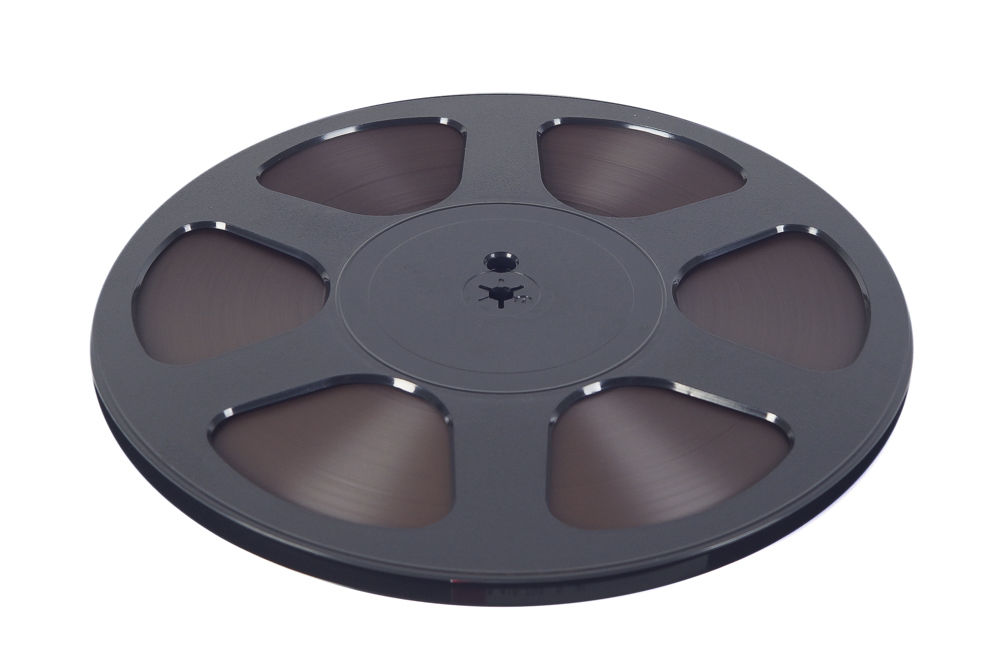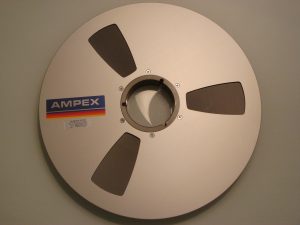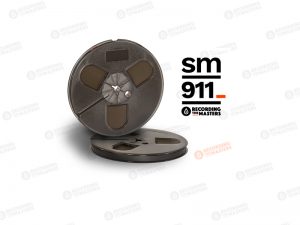Introduction to Reel to Reel Tapes
Jul 07 2016
LPR 35 1/4″ tape on 10,5″ plastic Trident reel – one of most widely used
There has never been a better time to start using reel tapes than now. Today these tapes are “polished” smoother than ever, which reduces the wear on heads. This is very important feature since magnetic head is the most critical part of the recorder. Modern tapes also have better signal to noise ratio. They have less tape noise (hiss) and you can record higher signal levels without distortion thus improving the signal to noise ratio. And thank God it is easy to choose a tape today! Because now there is practically only one manufacturer who’s line-up of Reel to Reel tapes consists only of 4 types or “formulas” of top of the line tapes.
Reel to Reel Tape Types
LPR35 – semi-professional tape, no.1 for home recordings. Most consumer machines will display best performance with this tape. It has the thinnest formula and provides 1.5 times longer recording on the same reel size as its professional SM counterpart tapes.
SM900, SM911, SM468 – professional tapes. Can record much higher levels of sound due to thicker magnetic coating.
All these 4 are original BASF tape “models” (later purchased by RMGI, EMTEC). Eventually in 2012 acquired by and named after manufacturer of magnetic recording media products PYRAL (acquired by MULANN Industries at Jan 2016 – see http://www.recordingthemasters.com/), these tapes are now manufactured according to BASF technologies in Avranches, France. Today you do not need to think – is this or that reel tape good enough? If you choose RMGI analogue audio tapes – they all are top grade. There is no 2nd grade. Truly. The fact is that RMGI has left in their tape line-up only top of the line models/formulas. You simply need to pick the right one – which is most suited for your needs or taste.
Therefore today to choose a new (manufactured nowadays) tape is easy. PYRAL is the only reel tape manufacturer left in the world.
There are also available the US based ATR tapes. However they make only one professional formula. It is a good one, but even more expensive and not widely used contrary to RMGI/PYRAL.

Ampex 795 1″ tape on high precision machined aluminium reel
New Old Stock (NOS)
If you want to mess around with NOS (new old stock) or old pre-recorded tapes, they will be either close in pricing to RMGI PYRAL or, if cheaper, then of lower grade. Like, for example, you may want to buy old AMPEX 632 labeled as NOS because of the musical content recorded on it. However not all makes/models have stood the test of time equally well.
I recommend Maxell as the best tape in such cases, and Scotch or TDK as second choice, because these two do show some shedding after some 30+ years of storage. Other makes show significant, dry shedding of magnetic material or SSS (Sticky Shed Syndrome) – the latter ones being not usable at all. They stick to the tape path so heavily, that after few minutes the recorder literally stops, and all parts where tape is sliding along is covered with gum like substance. This is caused due to incorrect binder technology, which was discarded in later years.
Tape lengths, reel sizes and recording times

SM911 1/4″ tape on 7″ plastic Trident Reel
There are 3 types of Reels available:
a) plastic “trident” reels
– the reel has a small central trident hole
– mostly 7 inch (18.0cm) or 10.5 inch (26.5cm) reels
b) metal reels with NAB mounting
– only 10.5 inch (26.5cm). Your recorder should have NAB hub adapters to be able to use these reels.
c) reel-less tapes (called “pancakes”). It is a “bare” tape wound on a plastic NAB adapter. Available only as 1
100m LPR35 or 762m all Pro tapes. These tapes you can use on recorders, which have special AEG type metal plates equipped with NAB adapters. Or you may buy separate new or used metal reels with NAB hubs and simply swap the tape-less NAB of the empty metal reel with the “pancake”.
What Tape Should You Use?
The rule of the thumb is – if you have a consumer (non -professional) tape recorder, which has the recording speed not higher than 7.5ips (19cm/s), you should use RMGI (PYRAL) model LPR35 tape (LPR35-Datasheet). This is the only and luckily the best tape available today of it’s type. It has an increased input/output level. It has a backcoating, therefore it winds better and has improved print through resistance compared to old non-backcoated tapes.
If your tape recorder has higher recording speed than 7.5ips – 15ips (38cm/s), then you should use Professional Tapes. It is still the best semi-professional tape out there and was used extensively in radio broadcasting studios. Indicator whether it is a professional or semi-professional machine, is the 15ips speed. Professional recorders are calibrated to the “thick” pro tape. These recorders are capable to utilize the full potential of Pro tapes – they can be precisely calibrated to the tape you choose and they can record much higher levels of sound due to the tape’s thicker magnetic coating. However you can still use the LPR35 – there will be no harm.
Pro Tapes
Worth taking in notice when choosing a Pro tape:
– SM900 (SM900-Datasheet) – high output tape. Most dynamic with highest output. Used for multi track and master recordings.
– SM911 (SM911-Datasheet) – studio master tape. The best all around and most popular Pro tape in the world.
– SM468 (SM468-Datasheet) – studio master for archiving. It has all the features of a master tape + it is designed for long storage. Originally its formula was created by AGFA. It has the best Print through protection and longest storage life. First tapes of this formula have been stored for more than 40 years – and display no deterioration of the coating or sound whatsoever. It is often chosen by professionals who specialize in classical, instrumental or voice recordings due to the “transparent” sound of its formula.
Remember – today’s tapes have improved characteristics compared to same model older tapes, therefore I recommend to use tapes which are manufactured recently.
Recording Time
The higher the speed and wider the track, the better sound quality can be achieved. However this makes less time available for recording. The following are details of recording times of both semi-professional and professional tapes:
- The long “thin” LPR35 tape with 10.5″ (26.5cm) reel size holds 3600ft (1100m) of tape; 7′ (18cm) holds 1800ft (549m) of tape. Recording times:
@ 3.75ips (9.5cm/s): 4-track recorder in both directions – 6h; using 2-track recorder on 2 stereo tracks on the full width of tape in only one direction: 3h
@ 7.5ips (19cm/s): 4 tracks both directions – 3h; 2 tracks one direction – 90min. The recording quality will be much higher.
@ 15ips (38cm/s): 4 tracks both directions – 90min; 2 tracks one direction – 45min. Available only on Pro or semi-Pro machines. The recording result will be true High End / Professional Standard, provided the source material delivers the quality. - The “thick” Professional tapes SM468, SM900, SM911 are roughly 1.5 times thicker and shorter. 10.5″ (26.5cm) reel holds 2500ft (762m) of tape; 7″ (18cm) reel holds 1200ft (366m) of tape. Recording times:
@ 7.5ips (19cm/s): 2 tracks one direction – 66min
@ 15ips (38cm/s): 2 tracks one direction – 33min
Normally these are used on professional 2 track machines and speed not less than 7.5ips (19cm/s), which is the lowest speed used by professionals. Of course, as mentioned before, you can use these tapes on 4 track recorders – then your recording times double by recording in both directions.
1000m Pro Tapes on Pancakes
The 1000m Pro tapes on pancakes are a German standard used in radio industry – now available only per special order. This length provides 87/43 minutes of recording time for corresponding 7.5/15 ips speeds on 2 tracks. Originally they were wound on special AEG kerns requiring a specific reel turntable, but now they can be ordered on NAB hubs. However you must be sure that your machine can accommodate this size of a reel. Consumer machines cannot, and even not all Pro recorders can. To mention just a few that support this option – they are all Swiss Studers – A80, A807MkII, A812, 810, 820. And plus Otari MTR-12.
What Do You Record on a Reel Tape?
If you want at true Analogue Sound, you can make copies of vinyl records. You may re-record your own vinyls to preserve them (vinyls wear too if they are played frequently). Or you can copy CDs or SACD, FLAC, WAV etc. files – just because you like your Reel to reel tape recorder.
It is also possible to use your R2R machine for recording live performances with microphones by plugging 2 mics directly (supported by most reel recorders). If you want to use more microphones, a mixing console will help a lot. Plus, you are suddenly a sound engineer 🙂 Help of a professional will speed up a learning curve. But since we live in Google world nowadays, you can get any information you need. Hope you have fun at your studio!
I thought it was interesting when you talked about how reel tapes are smoother than ever and are good to use. As far as I know, reels are used by film companies and movie theaters to record and play movies. It would be interesting to learn more about how the process of putting a movie on tape and reel works.